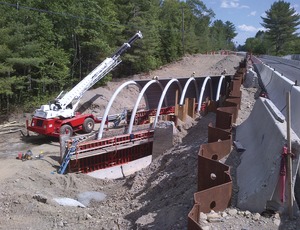
Four years after the first lightweight bridge-in-a-backpack, or BIAB, composite bridge was erected in Pittsfield, Maine, the technology is gaining traction in the U.S. and abroad, despite some learning-curve challenges.
So far, BIAB has been deployed for 13 bridges in four states and, completed in May, a 26-ft span for the Trinidad Ministry of Transportation. Construction is under way for a BIAB in Michigan, and Rhode Island is planning an installation.
BIAB technology reached a milestone in July 2012 when the American Association of State Highway and Transportation Officials agreed to accept BIAB design standards into its codes—a first for composite materials.
"The more tools we have available, the better," says Wayne Frankhauser, assistant bridge program manager for the Maine Dept. of Transportation, which completed two BIAB bridges this year and a total of eight since 2008. "The cost will be a little higher until the bugs are worked out, but it's safe to say we're seeing improvements on all fronts," he says.
The inflatable composite bridge arches were developed by Advanced Infrastructure Technologies in collaboration with the University of Maine, both in Orono (ENR 5/24/10 p. 25). After inflating hollow carbon-fiber tubes that can be bent to any geometry on-site, they are infused with resin, filled with consolidating concrete, then decked, backfilled and paved.
Crews are in phase two of the $1.2-million LaGrange Bridge, a 37-ft span with a 56° skew over a recreational trail on Route 16 that is scheduled for completion next month. Using 12-in. to 15-in. flexible tubes, "we were capable of arranging them to allow for a high degree of skew to fit the crossing," says Nate Benoit, project manager, MaineDOT. The technology enabled the road to stay open during construction, he notes.
MaineDOT and crews from Sargent Corp., Bangor, also used BIAB for a 34-ft span with a 25° skew on Route 180, which crosses Grey's Brook. Completed in June, the $750,000 project took eight months.
The longest BIAB structure completed in Maine is the Caribou Connector, a 54-ft span over a farm access road on a new roadway that finished in 2011. "We went to a 15-inch-diameter tube and composite walls," Benoit says. "We needed a more rugged tube to handle the span."



Post a comment to this article
Report Abusive Comment